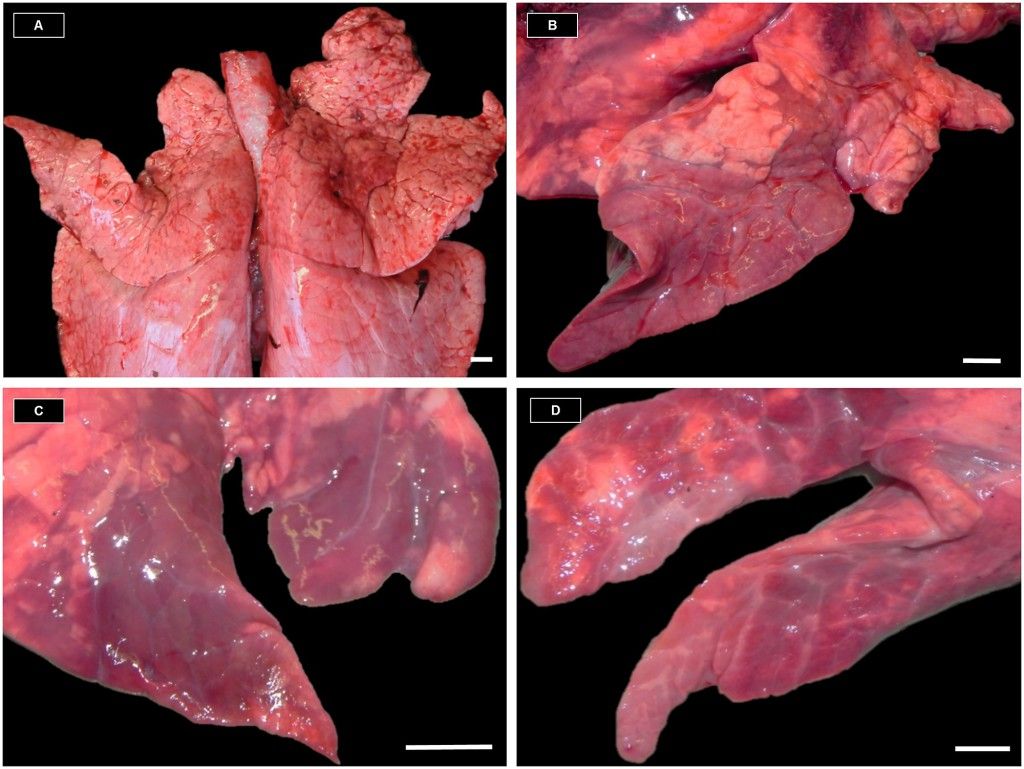Enzootic pneumonia is caused by the bacterium Mycoplasma hyopneumoniae. It is widespread in populations of pigs and is endemic in most herds around the world. It is transmitted either by contact with sick and healthy pigs or by air to a distance of 2.5-3 km if climatic conditions permit.
The bacterium quickly dies in the external environment, especially when drying. In wet conditions, it lasts from two to three days. The incubation period ranges from two to eight weeks. Under good conditions of maintenance and management, the course of the disease without complications does not pose a threat to the body.
However, mycoplasmosis can have more serious consequences in the presence of such diseases as actinobacillus pleuropneumonia (APP), pasteurellosis, hemophilia, PRRS or influenza. Mycoplasmosis always affects the apical and cardiac lobes, sometimes an additional or middle part of the diaphragmatic lobe, causing an increase in the density of the lung tissue up to the soft tissue, hepatic.
If more than 15% of the lungs are affected, it is very likely that mycoplasmosis is present in the population. In herds safe for M. hyopneumoniae, the number of affected lungs is from 1 to 2% and the volume of compacted tissues is very small.
If there is no mycoplasmosis, then the effects caused by other pathogenic microorganisms are greatly reduced. Therefore it is believed that M. hyopneumoniae opens the gateway of infection for other diseases.
Clinical symptoms
Acute form
The acute form can usually be observed at the first hit of M. hyopneumoniae in the herd. During the period from six to eight weeks after infection, severe acute pneumonia, cough, respiratory failure, fever and high mortality in all age groups are observed. This clinical form is extremely rare and often complicated by other pathogens.
Chronic form
Under normal conditions, the pathogen may persist in the herd for a long period. Maternal antibodies are transmitted through colostrum to piglets and they develop colostral immunity, which lasts from seven to twelve weeks, after which clinical symptoms begin to appear. The disease is accompanied by a long incessant cough, in some animals breathing is difficult and signs of pneumonia appear.

При убое поражение легких выявляют в от 30 до 100 % легких
Diagnostics
In most cases, the diagnosis is based on a clinical picture and postmortem lung diagnosis in pigs.
For laboratory confirmation, one or more studies are performed: an ELISA test, histological examination of stained lung preparations, a complement fixation reaction, a polymerase chain reaction reaction, an enzyme immunoassay, or isolation of a pure culture of the causative agent.
Similar diseases
A slight compaction of the anterior lobes of the lung can be caused by other pathogens, such as: influenza, PRRS, hemophilia, some viruses or other mycoplasmas.
Treatment
In dysfunctional farms, treatment should be based on the following principles:
- Separate maintenance of animals aged 10 to 20 weeks;
- Antibiotic therapy (lincomycin, tetracycline, tiamulin, tylosin);
- Culling of seriously sick animals;
- Symptomatic therapy.
Antibiotics only prevent the development of clinical signs but do not release the animal from the pathogen.
Prevention and Management
The basis for the prevention and improvement of mycoplasmosis is the vaccination of piglets.
For mycoplasmosis-free farms
The main place in the prevention of the disease is given to veterinary-sanitary and zoogenic hygiene measures. Pigs for the acquisition of farms should be purchased only in well-to-do farms, quarantine them after delivery and carefully investigate to identify mycoplasma carriers.
It is necessary to create optimal conditions for keeping and feeding, to observe the breeding of pigs by cycles, the density of planting, to conduct technological sanitary ruptures when placing animals.
The increase in morbidity is due to:
- Excessive density of animals in machines and premises;
- Temperature change and drafts;
- Supercooling;
- High humidity of environment;
- High levels of carbon dioxide and ammonia in the room;
- Poor sanitation;
- High dust content of the air;
- Moving and mixing pigs, stress;
- Lack of fodder;
- Poor-quality or inadequate feeding;
- A sharp change in the diet;
- Less than 3 cubic meters of airspace and 0.7 square meters. Metro area on the head;
- No air circulation in the room;
- The presence of diseases such as PRRS, Aujeszky's disease, APP, influenza.
To control mycoplasmosis and respiratory diseases in dysfunctional farms:
- vaccination;
- Optimization of the number of animals in machines and premises;
- Strict control over sanitation and hygiene in the premises;
- Control of dustiness of premises, optimization of grinding of mixed fodders for its reduction;
- Optimization of ventilation;
- Do not allow mixing and simultaneous maintenance of pigs of different age groups;
- Strict observance of the technology "empty-busy" and the implementation of the technological gap.
A source:thepigsite.com




